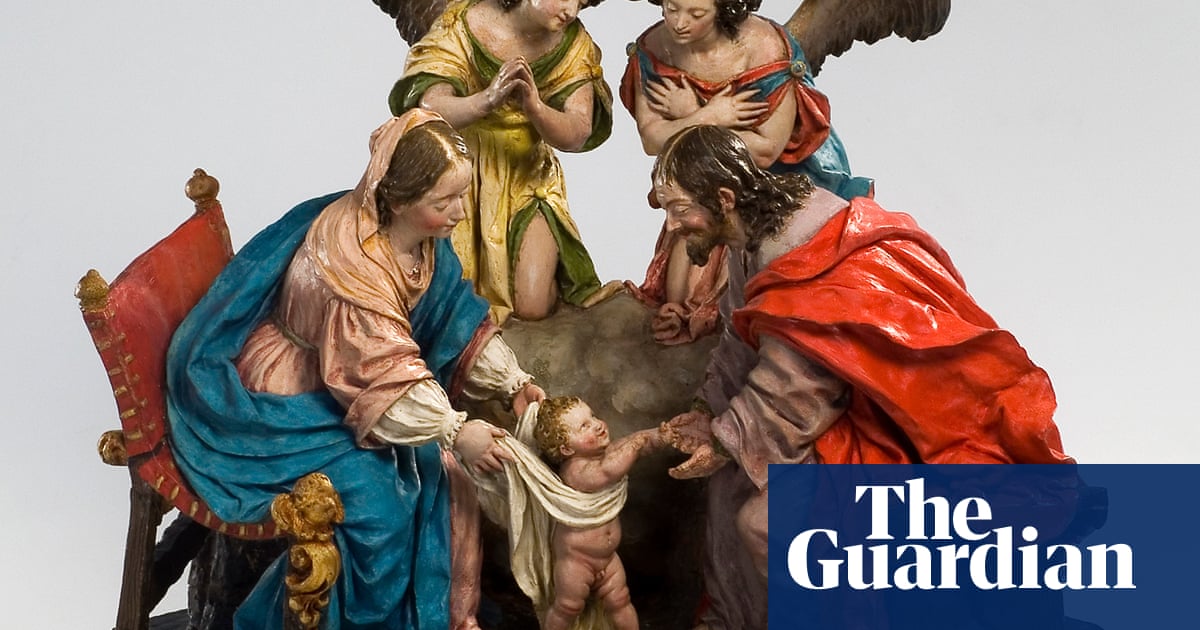In a darkened corner of the Prado, not far from an outsized crucifixion and a sculpture of a dead, recumbent Christ with eyes of glass, teeth of ivory and fingernails of horn, is another depiction of Jesus that is remarkable in its poignancy, its humanity and its history.
The tiny, painted terracotta scene, titled Los primeros pasos de Jesús (Jesus’s First Steps), is domestic rather than divine and shows a chubby, beaming infant ambling towards his equally beaming father. Its creator was the Spanish baroque artist Luisa Roldán who, despite becoming the first female sculptor to the royal court in 1692, is only now making her debut in the hallowed Madrid museum.
Roldán is being exhibited alongside fellow artists such as Alonso Berruguete and Gregorio Fernández as part of a new show that aims to rescue polychrome sculpture – the expert application of coloured paint to statues – from centuries of haughty indifference.
Roldán, popularly known as La Roldana, was the daughter of another famous Spanish baroque sculptor, Pedro Roldán. Her talents and ability to capture mood and emotions in her creations caught the eye of the royal court and she served Carlos II and Philip V.
The exhibition, Hand in Hand: Sculpture and Colour in the Spanish Golden Age, seeks to show that the western artistic canon has not only discriminated against certain artists on the grounds of geography and gender, but also because of the materials they used.
“For a long time, people thought only marble and bronze sculptures were great art, and that wooden or polychrome wooden sculptures belonged to a lesser category,” said the Prado’s director, Miguel Falomir. “That’s a very biased view of ancient art, based on the idea that classical artists only used marble and bronze and that they did not use colour.”
To that end, the show begins with a first century AD sculpture of Venus, found in a house in Pompeii in 1873, that still bears traces of its original paint.
Venus Lovatelli with Small Idol. From a Pompeian workshop in Pharos marble and remains of polychromy, first century AD. Photograph: Giorgio Albano MannAccording to the show’s curator, Manuel Arias, the polychrome statues were intended as a kind of visual theatre, just as their classical forerunners had been.
“These sculptures were meant to persuade people – but we didn’t invent them,” he said. “It’s about seeing that all this forms part of a sequence that was interrupted during the Renaissance, when they started to make archaeological discoveries of sculptures that had lost their polychrome and which gave rise to the idea that the sculptures of antiquity were white.”
Arias, who is the head of the sculpture department at the Prado, said the devotional statues were designed to startle and beguile those who beheld them.
I am Thirsty by Gregorio Fernández. Polychrome wood enhanced by other media 1612–16. Photograph: Museo Nacional de EsculturaIn the case of Gregorio Fernández’s recumbent, tortured Christ, the viewer’s feelings would have been pity, horror and awe. But Roldán’s miniature sculpture of the holy family is more likely to elicit pangs of tenderness and recognition.
“I think La Roldana was a great sculptor who was able to transmit emotion through small objects,” said Arias. “While she made sculptures of different sizes, these small pieces really reflect her importance as the transmitter of a very concrete message. It’s more intimate. This is closeup stuff and it shows her importance.”
That importance will be celebrated further later this month when the National Sculpture Museum in Valladolid opens an exhibition celebrating the artist, who died in 1706. The show, Luisa Roldán: Escultora Real, will be the first the museum has dedicated to a female sculptor.
“There’s a play on words in the title,” says the show’s curator, Miguel Ángel Marcos. “Real in Spanish has two meanings – royal and real. So it’s playing on her being a sculptor to the king – which was the highest honour to which an artist during the Spanish baroque could aspire – and that fact that she was a real sculptor whose importance was hobbled because she was a woman.”
Polychrome wood enhanced by other media, circa 1671, by Saint Ferdinand Pedro Roldán (sculptor) and Luisa de Valdés (polychrome artist). Photograph: Alberto Otero HerranzFor Marcos – as for his colleagues at the Prado – the remarkable thing about La Roldana was her blend of technical ability and humanity, a blend that transcends the straightforwardly devotional.
“One of the singular things about her style is the fact that many of her figures are smiling and sometimes openly laughing,” he said. “At the time, smiling wasn’t really seen as a good thing, so that shows how singular and independent her style was. There’s a very human touch.”
∎



